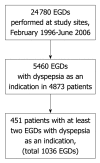Rate and yield of repeat upper endoscopy in patients with dyspepsia
- PMID: 20503451
- PMCID: PMC2877181
- DOI: 10.3748/wjg.v16.i20.2520
Rate and yield of repeat upper endoscopy in patients with dyspepsia
Abstract
Aim: To determine the rate and yield of repeat esophagogastroduodenoscopy (EGD) for dyspepsia in clinical practice, whether second opinions drive its use, and whether it is performed at the expense of colorectal cancer screening.
Methods: We performed a retrospective cohort study of all patients who underwent repeat EGD for dyspepsia from 1996 to 2006 at the University of California, San Francisco endoscopy service.
Results: Of 24,780 EGDs, 5460 (22%) were performed for dyspepsia in 4873 patients. Of these, 451 patients (9.3%) underwent repeat EGD for dyspepsia at a median 1.7 (interquartile range, 0.8-3.1) years after initial EGD. Significant findings possibly related to dyspepsia were more likely at initial (29%) vs repeat EGD (18%) [odds ratio (OR), 1.45; 95% confidence interval (CI): 1.20-1.75, P < 0.0001], and at repeat EGD if the initial EGD had reported such findings (26%) than if it had not (14%) (OR, 1.32; 95% CI: 1.08-1.62, P = 0.0015). The same endoscopist performed the repeat and initial EGD in 77% of cases. Of patients aged 50 years or older, 286/311 (92%) underwent lower endoscopy.
Conclusion: Repeat EGD for dyspepsia occurred at a low but substantial rate, with lower yield than initial EGD. Optimizing endoscopy use remains a public health priority.
Figures
Similar articles
-
Repeat upper gastrointestinal endoscopy in patients with functional dyspepsia: yield, findings, and predictors of positive findings.Gastroenterol Res Pract. 2015;2015:904683. doi: 10.1155/2015/904683. Epub 2015 Apr 12. Gastroenterol Res Pract. 2015. PMID: 25954308 Free PMC article.
-
The Initial Management and Endoscopic Outcomes of Dyspepsia in a Low-Risk Patient Population.Dig Dis Sci. 2016 Oct;61(10):2942-2948. doi: 10.1007/s10620-016-4051-3. Epub 2016 Feb 5. Dig Dis Sci. 2016. PMID: 26846116
-
The optimal age threshold for screening upper endoscopy for uninvestigated dyspepsia in Taiwan, an area with a higher prevalence of gastric cancer in young adults.Gastrointest Endosc. 2005 Jun;61(7):819-25. doi: 10.1016/s0016-5107(05)00366-4. Gastrointest Endosc. 2005. PMID: 15933682
-
Age Cutoff and Yield of Prompt Esophagogastroduodenoscopy to Detect Malignancy in Vietnamese with Upper Gastrointestinal Symptoms: An Endoscopic Database Review of 472,744 Patients from 2014 to 2019.Can J Gastroenterol Hepatol. 2021 Dec 11;2021:1184848. doi: 10.1155/2021/1184848. eCollection 2021. Can J Gastroenterol Hepatol. 2021. PMID: 34931167 Free PMC article. Review.
-
Gastrointestinal endoscopy in high-risk patients.Dig Dis. 1996 Jul-Aug;14(4):228-44. doi: 10.1159/000171555. Dig Dis. 1996. PMID: 8843979 Review.
Cited by
-
Investigating functional dyspepsia in Asia.J Neurogastroenterol Motil. 2012 Jul;18(3):239-45. doi: 10.5056/jnm.2012.18.3.239. Epub 2012 Jul 10. J Neurogastroenterol Motil. 2012. PMID: 22837871 Free PMC article.
-
Repeat upper gastrointestinal endoscopy in patients with functional dyspepsia: yield, findings, and predictors of positive findings.Gastroenterol Res Pract. 2015;2015:904683. doi: 10.1155/2015/904683. Epub 2015 Apr 12. Gastroenterol Res Pract. 2015. PMID: 25954308 Free PMC article.
-
Esophagogastroduodenoscopy in Patients Aged 75 Years and Older: A Single-Center Study.Cureus. 2022 Feb 2;14(2):e21846. doi: 10.7759/cureus.21846. eCollection 2022 Feb. Cureus. 2022. PMID: 35291530 Free PMC article.
-
Intestinal Metaplasia Associated with Symptoms of Dyspepsia.Res Sq [Preprint]. 2023 Oct 3:rs.3.rs-3335631. doi: 10.21203/rs.3.rs-3335631/v1. Res Sq. 2023. PMID: 37886477 Free PMC article. Preprint.
References
-
- Talley NJ, Zinsmeister AR, Schleck CD, Melton LJ 3rd. Dyspepsia and dyspepsia subgroups: a population-based study. Gastroenterology. 1992;102:1259–1268. - PubMed
-
- Heading RC. Prevalence of upper gastrointestinal symptoms in the general population: a systematic review. Scand J Gastroenterol Suppl. 1999;231:3–8. - PubMed
-
- El-Serag HB, Talley NJ. Systemic review: the prevalence and clinical course of functional dyspepsia. Aliment Pharmacol Ther. 2004;19:643–654. - PubMed
-
- Piessevaux H, De Winter B, Louis E, Muls V, De Looze D, Pelckmans P, Deltenre M, Urbain D, Tack J. Dyspeptic symptoms in the general population: a factor and cluster analysis of symptom groupings. Neurogastroenterol Motil. 2009;21:378–388. - PubMed
-
- Talley NJ, Vakil NB, Moayyedi P. American gastroenterological association technical review on the evaluation of dyspepsia. Gastroenterology. 2005;129:1756–1780. - PubMed
MeSH terms
LinkOut - more resources
Full Text Sources
Medical


